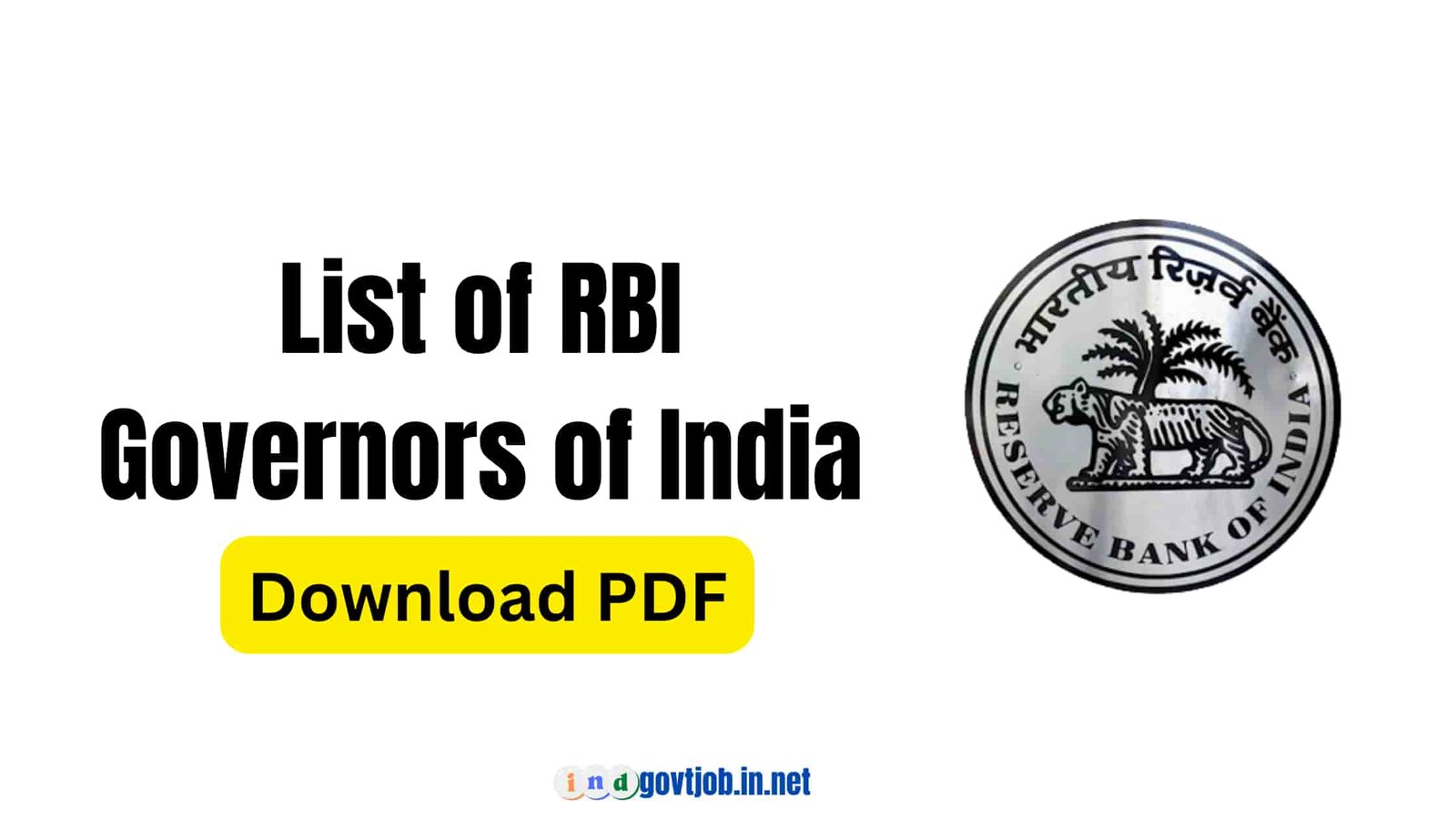List of RBI Governors of India - PDF Download
In this article, you can download the complete list of RBI Governors from 1935 to 2023.

In this article, you can download the complete list of RBI Governors from 1935 to 2023.
Home / Published on Feb 02, 2023

The Reserve Bank of India (RBI) is the central bank of India and is responsible for regulating the country's monetary policy.
The Governor of the RBI is the head of the bank and is appointed by the president of India for a term of three years. The Governor is responsible for overseeing the functioning of the bank and making decisions regarding interest rates, credit policy, and currency management.
The Governor also serves as the chariman of the central board of directors of the RBI and as the ex-officio chairman of the Financial stability and development council.
Today, In this post, we'll see the complete list of RBI governor of India from 1935 to current year. You can also download pdf of list of RBI governor of India.
| RBI Governors Names | Tenure |
|---|---|
| Sir Osborne Smith | 1 April 1935 - 30 June 1937 |
| Sir James Braid Taylor | 1 July 1937 - 17 Feb 1943 |
| Sir. C.D. Deshmukh | 11 Aug 1943 - 30 June 1949 |
| Sir Bengal Rama Rau | 1 July 1949 - 14 Jan 1957 |
| K.G. Ambegaonkar | 14 Jan 1957 - 28 Feb 1957 |
| H.V.R. Lyengar | 1 March 1957 - 28 Feb 1962 |
| P.C Bhattacharya | 1 March 1962 - 30 June 1967 |
| L.K. Jha | 1 July 1967 - 3 May 1970 |
| B.N. Adarkar | 4 May 1970 - 15 June 1970 |
| S. Jagannathan | 16 June 1970 - 19 May 1975 |
| N.C. Sen Gupta | 19 May 1975 - 19 Aug 1975 |
| K.R. Puri | 20 Aug 1975 - 2 May 1977 |
| M. Narasimham | 3 May 1977 - 30 Nov 1977 |
| I.G. Patel | 1 Dec 1977 - 15 Sep 1982 |
| Manmohan Singh | 16 Sep 1982 - 14 Jan 1985 |
| Amitav Gosh | 15 Jan 1985 - 4 Sep 1985 |
| R.N. Malhotra | 4 Feb 1985 - 22 Dec 1990 |
| S. Vpnldraramanan | 22 Dec 1990 - 21 Dec 1992 |
| C. Rangarajan | 22 Dec 1992 - 21 Nov 1997 |
| Bimal Jalan | 22 Nov 1997 - 6 Sep 2003 |
| Y.V. Reddy | 6 Sep 2003 - 5 Sep 2008 |
| D. Subbarao | 5 Sep 2008 - 4 Sep 2013 |
| Raghuram G Rajan | 4 Sep 2013 - 4 Sep 2016 |
| Urjit Ravindra Patel | 4 Sep 2016 - 10 Dec 2018 |
| Shaktikanta Das | 12 Dec 2008 - Current Year |
The Reserve Bank of India (RBI) has a central board of directors, which is responsible for the overall direction and supervision of the bank's functions. The board is comprised of the following members.
The central board of directors is responsible for making decisions on important issues such as monetary policy, credit policy, and financial regulation, among others. The board also acts as a link between the RBI and the government.
The powers of the Governor of the Reserve Bank of India (RBI) are defined by the Reserve Bank of India Act, 1934. The governor is the head of the RBI and has a significant role in the functioning of the bank. Some of the key powers and responsibilities of the Governor include:
Formulating and implementing monetary policy: The Governor is responsible for formulating and implementing monetary policy to regulate the supply of money and credit in the economy, and to ensure price stability.
Regulating the banking system: The governor has the power to regulate the banking system in India, including the licensing and supervision of banks, and the regulation of their activities.
Managing foreign exchange: The governor has the power to manage the foreign exchange reserves of the country and to regulate foreign exchange transactions.
Overseeing financial stability: The governor is responsible for ensuring the stability of the financial system in India and for taking steps to prevent and resolve financial crises.
Representing the RBI: The governor is the official representative of the RBI and acts as a liaison between the bank and the government, as well as with other central banks and international financial organizations.
Overall, the Governor has a key role in shaping the direction of the Indian economy and in ensuring the stability of the financial system.
The qualifications for appointment as the Governor of the reserve bank of India are not specifically defined in the Reserve Bank of India Act, 1934. However, typically, the Governor is appointed from among individuals who have a background in economics, banking, or finance, and who have had experience in public administration, financial regulation, or monetary policy.
In general, the Governor should have a strong understanding of economic and financial issues, and should have the following qualities:
Also Download PDF:
| First in India Female | First in India Male |
| List of Prime Minister of India | List of National Park in India |
| List of Tiger Reserve in India | List of Dams in India |
Here are some frequently asked questions (FAQs) on the Governor of the Reserve Bank of India (RBI):

SHARE IT